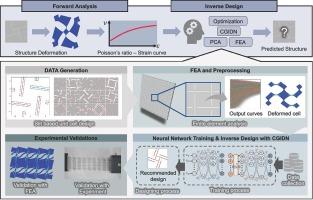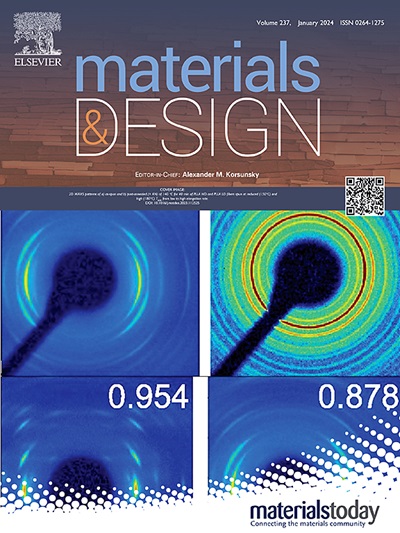利用约束生成式逆向设计网络定制超材料设计,以实现所需的应变泊松比
IF 7.6
2区 材料科学
Q1 MATERIALS SCIENCE, MULTIDISCIPLINARY
引用次数: 0
摘要
反向设计具有定制应变泊松比的超材料结构,在各种应用中具有巨大潜力。然而,由于几何形状与机械性能之间的复杂关系,实现对这些机械特性的精确控制是一项挑战。在此,我们提出了一种新颖的数据驱动方法,利用受限生成式逆向设计网络(CGIDN)来应对这一挑战。CGIDN 使用反向传播来高效地浏览设计空间,并高精度地实现目标机械性能。我们的方法首先为各种几何形状生成一个包含切口的泊松比-应变曲线综合数据集。然后使用主成分分析 (PCA) 对这些曲线进行压缩,以降低维度,同时保留基本特征。然后对深度神经网络(DNN)进行训练,将输入的几何参数映射到这些主成分上,并使用网格搜索对架构进行优化。CGIDN 通过推荐与指定目标泊松比-应变曲线相匹配的单元格设计几何参数,促进了逆向设计过程。我们通过有限元分析(FEA)和实验验证了我们方法的有效性。设计的单元格的有限元分析结果显示与目标曲线和预测曲线高度一致,证明了 CGIDN 模型的准确性。此外,试样的拉伸试验证实,逆向设计的结构在放大后再现了所需的机械性能。我们的方法能高效、准确地设计出具有定制机械特性的超材料,有望应用于可穿戴设备、软机器人和先进传感器系统。本文章由计算机程序翻译,如有差异,请以英文原文为准。

Customizable metamaterial design for desired strain-dependent Poisson’s ratio using constrained generative inverse design network
Inverse design of metamaterial structures with customized strain-dependent Poisson’s ratio has significant potential across various applications. However, achieving precise control over these mechanical properties presents a challenge due to the complex relationship between geometry and mechanical performance. Here, we present a novel data-driven approach utilizing a constrained generative inverse design network (CGIDN) to address this challenge. The CGIDN uses backpropagation to efficiently navigate the design space and achieve target mechanical properties with high accuracy. Our method starts by generating a comprehensive dataset of Poisson’s ratio-strain curves for various geometries incorporating cuts. These curves are then compressed using principal component analysis (PCA) to reduce dimensionality while preserving essential features. A deep neural network (DNN) is then trained to map input geometric parameters to these principal components, with the architecture optimized using grid search. The CGIDN facilitates the inverse design process by recommending geometric parameters for unit cell designs that match specified target Poisson’s ratio-strain curves. We validated the effectiveness of our approach through Finite Element Analysis (FEA) and experimental verification. The FEA results for the designed unit cells showed high agreement with the target and predicted curves, demonstrating the accuracy of the CGIDN model. Further, tensile tests on specimens confirmed that the inverse-designed structures reproduced the desired mechanical behavior upon scale-up. Our method, which enables efficient and accurate design of metamaterials with tailored mechanical properties, holds promise for applications in wearable devices, soft robotics, and advanced sensor systems.
求助全文
通过发布文献求助,成功后即可免费获取论文全文。
去求助
来源期刊

Materials & Design
Engineering-Mechanical Engineering
CiteScore
14.30
自引率
7.10%
发文量
1028
审稿时长
85 days
期刊介绍:
Materials and Design is a multi-disciplinary journal that publishes original research reports, review articles, and express communications. The journal focuses on studying the structure and properties of inorganic and organic materials, advancements in synthesis, processing, characterization, and testing, the design of materials and engineering systems, and their applications in technology. It aims to bring together various aspects of materials science, engineering, physics, and chemistry.
The journal explores themes ranging from materials to design and aims to reveal the connections between natural and artificial materials, as well as experiment and modeling. Manuscripts submitted to Materials and Design should contain elements of discovery and surprise, as they often contribute new insights into the architecture and function of matter.
 求助内容:
求助内容: 应助结果提醒方式:
应助结果提醒方式:


